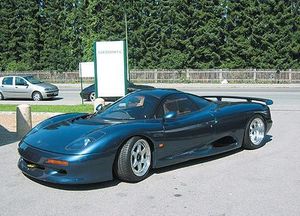.
Jaguar XJR-15: Difference between revisions
Red marquis (talk | contribs) No edit summary |
Red marquis (talk | contribs) No edit summary |
||
| Line 49: | Line 49: | ||
| {{{Designer (lead designer if it was a team effort)}}} | | {{{Designer (lead designer if it was a team effort)}}} | ||
|} | |} | ||
The '''Jaguar XJR-15''' is a rare [[supercar]] produced by [[Jaguar Cars|Jaguar]]. Only 50 were made, each selling for US$960,165. Based mechanically on the [[24 hours of Le Mans|Le Mans]]-winning [[Jaguar XJR-9]], the car had an aerodynamic body designed by [[Peter Stevens]], who later went on to design the [[McLaren F1]]. | The '''Jaguar XJR-15''' is a rare [[supercar]] produced by [[Jaguar Cars|Jaguar]]. Only 50 were made, each selling for US$960,165. Based mechanically on the [[24 hours of Le Mans|Le Mans]]-winning [[Jaguar XJR-9]], the car had an aerodynamic body designed by [[Peter Stevens]], who later went on to design the [[McLaren F1]]. | ||
Revision as of 00:45, 25 June 2007

| |
| Jaguar XJR-15 | |
|---|---|
| Jaguar | |
| aka | {{{aka (Type here, not up there)}}} |
| Production | {{{produced from when to when+total units made (optional)}}} |
| Class | {{{Class}}} |
| Body Style | {{{Body-Style}}} |
| Length | {{{length - type here}}} |
| Width | {{{Width - type here}}} |
| Height | {{{Height - type here}}} |
| Wheelbase | {{{wheelbase - type here}}} |
| Weight | {{{Weight - you get the point}}} |
| Transmission | {{{transmission + drive}}} |
| Engine | {{{engine}}} |
| Power | {{{Horsepower and Torque rating}}} |
| Similar | {{{similar (competition)}}} |
| Designer | {{{Designer (lead designer if it was a team effort)}}} |
The Jaguar XJR-15 is a rare supercar produced by Jaguar. Only 50 were made, each selling for US$960,165. Based mechanically on the Le Mans-winning Jaguar XJR-9, the car had an aerodynamic body designed by Peter Stevens, who later went on to design the McLaren F1.
The car's production was announced in a press release on November 15, 1990. It was then built by Jaguar Sport in Coventry, England from 1990 to 1992. While all are now privately owned, some were built for professional racing.
The mid-engine, rear-wheel drive supercar is powered by a 450 hp, naturally aspirated V12 engine of 5,993cc, and has a 6-speed manual transmission. The XJR-15’s chassis and bodywork are composed of carbon fiber and Kevlar, and its engine features an advanced electronically managed fuel injection system. The XJR-15 has a 0-60 mph time of 3.1 seconds and a top speed of 185 mph.
Because of its V12 engine, power-hungry buyers saw the XJR-15 as an attractive alternative to the Jaguar XJ220, which was powered by a twin turbo V6. The XJ220 was also a limited production vehicle, of which 271 were built.
The XJR-15 stemmed from a concept car by Jaguar Sport and Tom Walkinshaw Racing (TWR) called Project R9R. The R9R was developed by Jaguar Sport for the purpose of testing the endurance of carbon and plastic bodywork at high speeds. It was based mechanically on the V12-powered XJR-9, which won the 1988 Le Mans. After thousands of miles of testing and thorough analysis, the R9R went into production as the Jaguar XJR-15 in 1990. According to a press release by Jaguar, it was built specifically with the 1991 Jaguar Sport Intercontinental Challenge in mind.
Sixteen of the cars were raced at the 1991 Jaguar Sport Intercontinental Challenge in Monaco. The event was a three-race competition held in August of that year. The winner, Armin Hahne, was awarded a cash prize of US$1 million.
While Jaguar never exported the XJR-15 out of Europe, at least three are known to have made their way to the United States. One was sold at the Pebble Beach Concours d’Elegance in 2001 for US$176,000. Another was sold at Pebble Beach in 2003 for US$154,000 (which was, incidentally, alongside a Jaguar XJ220 which sold for US$157,500).
The most recent was sold at the Bonhams & Butterfields Auction in Carmel, CA in August 2004. It is reported to have been sold to a private collector for around US$175,000. The auctioned car in question was originally ordered in 1991 by British pop music producer Matt Aitken, who participated in races supporting that year's Monaco Grand Prix and Belgian Grand Prix.
Error creating thumbnail: Unable to save thumbnail to destination
| ||
| JAGUAR | ||
|
Tata Motors | Jaguar | Land Rover | Hispano Carrocera SA | Tata Daewoo Commercial Vehicle | Daewoo Bus Current Models: XF (R) · XJ (R) · XK (R) Historic Models: X-Type · E-Type · XJS · XKSS · XK120 · XK140 · XK150 · XJ220 · 240 · 340 · Mk. VII · Mk. VIII · Mk. IX · Mk. X · Mk. V · Mk. IV · Mark 2 · Mark 1 · 3.5 Litre · 2.5 Litre · 1.5 Litre · S-Type (1963-1968) · 420 · S-Type · SS100 · XJR-15 Concept Cars: C-XF · R-Coupe · RD-6 · Fuore XF 10 · Pirana Concept · XK180 Concept · F-Type Concept · XK-RR Concept · XK-RS Concept · Concept Eight · XJ Limo Green Hybrid Study Concept · XJ75 Platinum Concept · C-X75 Concept One-Offs: XJ13 Racing Vehicles: C-Type · D-Type · XJR-5 · XJR-6 · XJR-7 · XJR-8 · XJR-9 · XJR-10 · XJR-11 · XJR-12 · XJR-14 · XJR-16 · XJR-17 · XJ-S · R1 · R2 · R3 · R4 · R5 · XKR GT3 · XKR GT2 · RSR XKR GT | ||
| Sir William Lyons | Corporate website | A brand of the Tata Group |
